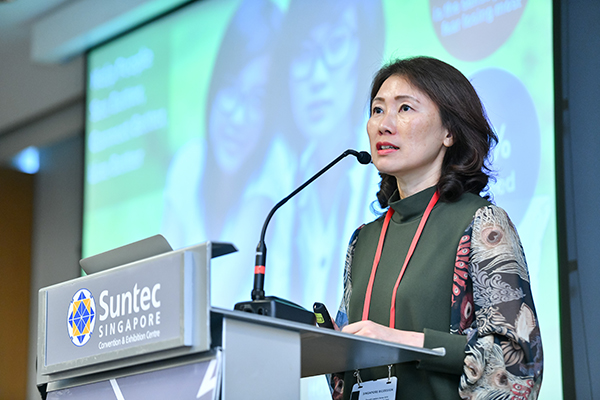If you take a stroll in Singapore’s West Coast Park, an expanse of playgrounds and walking paths that runs alongside a busy container port, you might notice signs that warn about the perils of myopia. Created by Singapore’s Health Promotion Board, a government-led public health organization, these signs feature slogans like “Keep Myopia at Bay, Take Your Kids Out to Play.”
Myopia is a major problem in Singapore and many other parts of East Asia, where prevalence of the condition exceeds 80% among young people in urban areas.1 With one of the world’s highest rates of this sight-threatening condition, Singapore can be considered as a hotspot in this growing global epidemic, which already affects more than 2 billion people around the world and is predicted to afflict half the world’s population by 2050.2
Widely known for its advanced and well-managed healthcare system, Singaporean policymakers had both the foresight and the resources to proactively address the nation’s myopia crisis. Through various public health measures, such as preventative health education campaigns and screening programs, they achieved a 5% reduction in myopia incidence at primary schools between 2004 and 2009.3
Other Asian countries have not been so fortunate. Across the region, and particularly in developing countries like Indonesia, millions of people lack access to effective and affordable treatment for myopia and other eye diseases. These treatment gaps often result in tragic outcomes for patients, many of whom will go blind due to causes that are fully preventable.
Yet as the burden of eye diseases increases in Asia, researchers and entrepreneurs from across the region are working on solutions for the region’s diverse challenges. At a recent event hosted by Singapore Biodesign, an Asia-focused medtech innovation program, experts and innovators from around the world came together to discuss these potential solutions and reimagine the future of eye care in Asia.
Thinking Online and Offline
Many experts agreed that the future of eye care will sit at the intersection of the digital and physical worlds. “We need to think online and offline, all the time, as that’s how we all live,” argued Bebe Teo, managing director, Seed Accelerate Sustain Cluster, Vision Care (Asia Pacific), Johnson & Johnson Vision. “We can’t have a solution that focuses only on the face-to-face.”

To help bridge the online and offline worlds, Teo said that Johnson & Johnson is working on mobile platforms that help patients to connect with eye care practitioners and access educational content about eye diseases. She also said her company is pursuing partnerships with some of Asia’s leading technology firms to identify and educate at-risk individuals.
Part of the challenge will involve addressing the underlying cultural factors that contribute to eye disease. To investigate this, the Singapore Biodesign Innovation Fellows followed the Biodesign methodology, which starts with needs identification and validation. They conducted in-person ground immersions at multiple eye care centers in Singapore, China and Indonesia. They noticed a sharp contrast in activity of young children across the countries, with young students in Singapore and China spending a large majority of daylight hours indoors and on screen compared to their counterparts in Indonesia.
One company working to address the behavioral factors is Plano, a Singapore-based startup that provides a variety of digital tools to promote eye health. This includes an app that helps children to regulate smartphone use and adopt healthy device habits, such as optimal face-to-screen distance and scheduled downtime.
Adapting to Local Needs
For most types of eye disease, the vast majority of cases occurring in Asia can be prevented or treated with existing, well-established technology. The bigger challenge, however, is localizing these technologies to meet the specific needs of Asian countries, particularly in low-resource territories that do not benefit from the most advanced medical technologies and treatments.
Indonesia is one of those countries. A typical patient receiving care through its national insurance system will often need to receive multiple referrals over the course of several months before they can visit a tertiary eye care center. Once there, they sometimes wait up to 12 hours for treatment, noted the Singapore Biodesign Fellows. This is even true for conditions like retinal detachment, which is considered a medical emergency in more developed countries.
Innovative medical technologies will play an important role in addressing these kinds of access challenges. One example is the Virna Glaucoma Drainage Device, a novel solution for glaucoma surgery that was launched in Indonesia in June 2019.4 Developed from a collaboration between a young Indonesian ophthalmologist and researchers at the Lions Eye Institute in Western Australia, this low-cost and easy-to-use surgical device is manufactured in Indonesia and costs only $100.

Investing in Eye Care Research
With eye diseases on the rise in much of Asia, public and private-sector investors are ramping up efforts to produce research and new technologies that can address unmet needs. Myopia remains a major focus, as evidenced by the November 2018 launch of a $26 million partnership between Johnson & Johnson Vision and the Singapore Eye Research Institute, one of the world’s top centers for ophthalmic and vision research.5
“Myopia is the great epidemic of our time, and Singapore should get credit for putting that on the map,” said Mark Blumenkranz, M.D., a professor emeritus in the Department of Ophthalmology at Stanford University, who has a long track record of innovation in eye care. Additionally, he believes that Singapore has massive potential to make further contributions towards early-stage ophthalmic drug and device development for the region.
Private sector VCs are also taking a growing interest in Asian ophthalmology. “When I started an early-stage fund in 2016 to focus on ophthalmology, few VCs were doing this,” observed Richel Liu, founder and CEO of Rimonci Capital, a Chinese venture fund that focuses on vision science and eye care. “Now, several funds are working to build the ophthalmic startup ecosystem, and more life sciences venture and private equity funds are making ophthalmology one of their key pipeline tracks.”
With evidence-based public health programs, novel technologies, and growing investment in ophthalmology, opportunities abound for addressing Asia’s many challenges in eye care. Over time, the region may increasingly emerge as an incubator for solutions that have global impact.
References
- Chen M, Aimin W, Zhang L, Wang W, Chen X, Yu X, Wang K (2018). The increasing prevalence of myopia and high myopia among high school students in Fenghua city, eastern China: a 15-year population-based survey. BMC Ophthalmology. 2018; 18: 159.
- Holden BA, Fricke TR, Wilson DA, Jong M, Naidoo KS, Sankaridurg P, Wong TY, Naduvilath TJ, Resnikoff S (2016). Global Prevalence of Myopia and High Myopia and Temporal Trends from 2000 through 2050. Ophthalmology, May 2016 Volume 123, Issue 5, 1036–1042.
- Singapore Health Promotion Board (November 11, 2011). “Singapore Achieves Breakthrough in Reducing Prevalence of Myopia by Almost 5%”. Accessed October 25, 2019.
- Medianet (June 25, 2019). “Australian-Indonesia invention developed to tackle Indonesia’s glaucoma crisis”. Accessed October 25, 2019.
- Singapore National Eye Centre (November 12, 2018). “Singapore Eye Research Institute and Johnson & Johnson Vision Set Sight on Halting Global Myopia Epidemic”. Accessed October 25, 2019.






